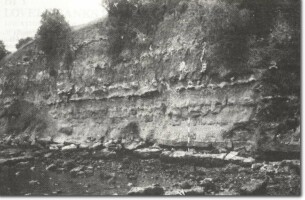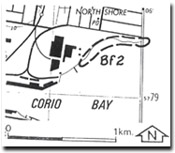Bf2 Geelong North Shore - Fyansford Clay
Geelong - Maude Area, Tertiary Stratigraphic Sites
This information has been developed from the publications:
|
| Location Access Ownership | Batesford - 695795. Former Shire of Corio. Coastal cliffs in Moorpanyal Park south of The Esplanade. The Esplanade. Crown land. |  Bf2 - Moorabool Viaduct Formation, Geelong. |
Site Description | The coastal cliffs 6 to 10 m high expose an excellent section in the Fyansford Formation overlain by the Moorabool Viaduct Sand. The beds are a facies variant of the Fyansford Formation, being mainly sandy or silty marl interbedded with calcareous clays and have a carbonate fraction considerably higher than that normally associated with the Fyansford Formation. | |
Significance | State. The outcrop is a major exposure of the Fyansford Clay and provides a clear example of a facies variant of the formation. They are unusual examples of vertical cliffs in a low energy wave environment with a boulder beach and covered shore platform. | |
Management | Class 1. The cliffs should be left as active marine features to allow use as teaching and reference sites. Building of protective or stabilizing structures is not necessary. These cliffs are one of the few remaining natural features on a coastline that has been substantially modified by industrial and transport activities. Although the cliffs are relatively stable, coastal land use planners need to recognise the dynamic nature of the site and refrain from placing coastal installations in positions of hazard. | |
References | Bowler, J.M. (1963). Tertiary Stratigraphy and Sedimentation in the Geelong/Maude Area, Victoria. Proc. R. Soc. Vict. 76:69-137. |



